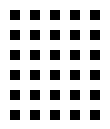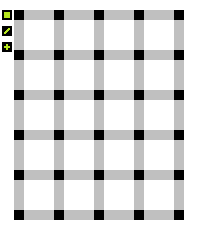Points
All unicursal mazes are comprised of points. A definition of a point, for the purposes of unicursal maze research is a place where a directional decision must be made.

In order for points to be used in a maze, they must be spaced evenly apart from one another. They must be assembled into a series of interconnected columns and rows. For the purposes of our research:
A column is defined as a vertical series of evenly-spaced points.

A row would be defined as a horizontal series of evenly-spaced points.

When these columns and rows are combined with one another, they create a field of points, otherwise referred to as just a "field." Indeed, a field is defined as an interconnected series of columns and rows. Below is an example of one such field of points:

In Unicursal Maze Research, fields are identified first by the number of columns, then by the number of rows. In the example above, the field would be identified as a "5x6": 5 columns by 6 rows.
Fields are ordered by their rows and then by their columns. For example, a 2x4 field comes first and then a 3x4 would be next, followed by a 4x4 square. The next field would be a 2x5 field, followed by a 3x5 field and so on until a 5x5 square. The next field beyond a 5x5 square would be a 2x6 field. This pattern of classification extends into infinity.
Below is an actual template for a 5x6 field, complete with a start, end and decision point ready to be pasted into the field as needed. The gray bars inbetween the points may be replaced with a variety of colors based upon the type of path being created, such as the color red for a determined path.

Types of Points
All points have the same function, which is to be a place where a directional decision must be made. However, different points have different names in order to distinguish their specific function within an unicursal maze.
A start point is where an unicursal maze begins; It is the first point occupied in an unicursal path. It is identified by having a green square.

An end point is the last point occupied in an unicursal path. It is identified by having a green cross.

A decision point is where an unicursal path may deviate and still be completed. It is identified by having a forward slash ("/").

With these three points, any unicursal maze may be rendered completely and faithfully for analytic purposes. In fact, you see such paths every day on the main page of this website. There's no need to scroll back to that page. Here is that maze, reproduced here for your convenience:

However, there is one further point that is of use.
A stop point is sometimes used for two purposes: To denote the premature end of a path due to a mistake of some type or to denote that a point in a field may never be entered. It is identified by having a red "X" symbol.

The following example is a bit embarrassing: It's an actual time that I made a mistake... For real! Nobody's perfect... Forgive me, Asterion?

And here's an example of an obstructed maze that uses stop points to denote points that can't be entered:

I hope that the above learning module has been instructive in teaching about points, fields, the different types of points and their practical applications.